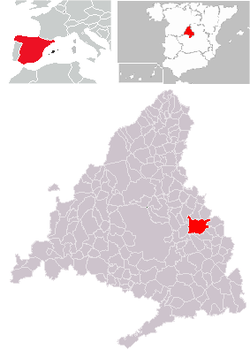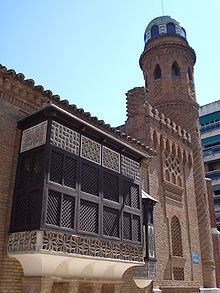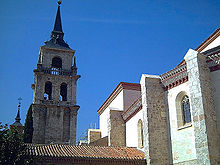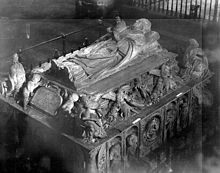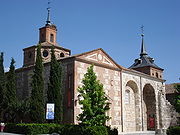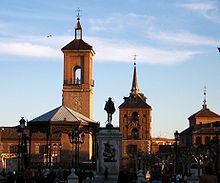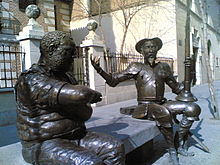- Alcalá de Henares
-
Alcalá de Henares — Municipality — 
Flag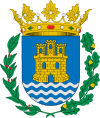
Coat of armsLocation in Spain Coordinates: 40°28′N 3°22′W / 40.467°N 3.367°WCoordinates: 40°28′N 3°22′W / 40.467°N 3.367°W Country  Spain
SpainAutonomous community Madrid Province Madrid Comarca Alcalá Founded Pre-Roman Government - Alcalde Bartolomé González Jiménez (PP) Area - Total 87.72 km2 (33.9 sq mi) Elevation 588 m (1,929 ft) Population (2008) - Total 203,645 - Density 2,321.5/km2 (6,012.7/sq mi) Demonym Complutense
Alcalaíno/aTime zone CET (UTC+1) - Summer (DST) CEST (UTC+2) Postal code 28801-28807 Official language(s) Website Official website University and Historic Precinct of Alcalá de Henares * UNESCO World Heritage Site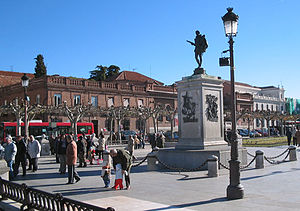
Country Spain Type Cultural Criteria ii, iv, vi Reference 876 Region ** Europe and North America Inscription history Inscription 1998 (22nd Session) * Name as inscribed on World Heritage List
** Region as classified by UNESCOAlcalá de Henares (Spanish pronunciation: [alkaˈla ðe eˈnaɾes]), meaning Citadel on the river Henares, is a Spanish city, whose historical centre is one of UNESCO's World Heritage Sites, and one of the first bishoprics founded in Spain. Located in the Autonomous Community of Madrid, 35 km northeast of the city of Madrid, at an altitude of 588 metres (1929 ft) above sea level, it has a population of around 200,000, the second largest of the region after the Spanish capital itself. The city is generally known simply as "Alcalá", but "de Henares" is often appended to differentiate it from a dozen cities sharing the name Alcalá (from the Arabic word al-qal'a القلعة for fortification or citadel). The Latin name, Complutum, is sometimes used also and the city is capital of its namesake region, Comarca de Alcalá.
Contents
The city today
The centre of the city remains essentially medieval, with many winding cobbled streets, and many historic buildings. The city centre surrounds Cervantes Square (the famous Plaza de Cervantes) and is traversed by a long pedestrian main street, the Calle Mayor.
The old city centre has been largely preserved, unlike the suburbs. There has been no clear planning by the city councillors regarding expansion, and the sprawling suburban areas are irregularly constructed, with the addition of seventies-style high rise blocks in many places.
One of the most important streets in the city is the Calle del Cardenal Cisneros which takes tourists from the Madrid Gate at the entrance of the city, to the old city center and the Cathedral in Santos Niños Square.
The city hosts a large population of international students due to the presence of the University, and in particular its Spanish language and literature programs for foreign students.
The Storks
Alcalá is well-known for its population of white storks. Their large nests can be observed atop many of the churches and historic buildings in the city, and are themselves a significant tourist attraction. Situated in the lowlands of the Henares river, the city is an attractive home for the migratory storks due to the wide availability of food and nesting material in the area.
For over twenty year's Alcalá's storks have been counted and studied, and the active protection and maintenance of their nests is by official policy. Although once in danger of disappearing, with only eleven pairs counted between 1986 and 1987, the population has grown to around 90 resident pairs today, many of which have shortened the distance and duration of their typical migrations to remain in the city nearly all year.[1]
History
The city boundaries have been inhabited since the Calcolithic phase of the Bronze Age. Romans conquered the area in the 1st century BC, and built the town of Complutum near a previous Celtiberian settlement, called Iplacea. Thus, it became the only Roman town in the Madrid region. With 10,000 inhabitants, it reached the status of Municipium and had its own governing institutions. After the falling apart of the Roman Empire, under the Visigoths, it declined, although it also became a pilgrimage place for the Saints Justo and Pastor.
When in 711 the Moors arrived, they subdued the Visigothic city and founded another site, building an al-qal'a, which means "citadel" in Arabic, on a nearby hill, today known as Alcalá la Vieja (Old Alcalá). On 3 May 1118 it was reconquered by the Archbishop of Toledo Bernardo de Sedirac in the name of Castile. The Christians preferred the Burgo de Santiuste ("Saint Just's borough") on the original Roman site and the Arab one was abandoned. The city was ceded to the Bishopric of Toledo, which granted it ferial rights. Under Christian rule until the end of the Reconquista, the city sported both a Jewish and a Moorish quarter and had a renowned marketplace. Its central position allowed it to be a frequent residence of the Kings of Castile, when travelling south.
At some time in the 1480s Christopher Columbus had his first meeting at the "Casa de la Entrevista" with the Reyes Católicos, Ferdinand and Isabella, who financed the travel for the Discovery of America.
The city suffered severe damage during the Spanish Civil War.
Historic figures and events
The author Miguel de Cervantes was born in Alcalá de Henares, and baptized in the Church of Santa Maria in 1547, although his family moved from the city when he was still young. The city celebrates his birthday, 9 October, every year and organizes an annual Cervantes festival. The local university is acknowledged as a global leader in the study of Cervantes and his works.
Every year on 23 April, the anniversary of Cervantes' death, the city of Alcalá hosts the ceremony awarding the Cervantes Prize, the Spanish-speaking world's most prestigious award for lifetime achievement in literature. The award is presented by the King of Spain at the University of Alcalá's historic "Colegio de San Ildefonso." Speeches about the importance of the Spanish language are customarily given by the King, the Minister of Culture and the laureate. The ceremony attracts a wide range of dignitaries to the city including members of the Royal Family, the Prime Minister, and others.
Other notable figures associated with the city are Ferdinand I of Aragon, cardinal Francisco Jiménez de Cisneros, the mystic John of the Cross, the theologian Gabriel Vázquez, the poet Juan Ruiz, Arcipreste de Hita, and Manuel Azaña Díaz, writer and politician, who was President of the Second Spanish Republic between 1933 and 1936.
The Cathedral[2]
Aside from the buildings associated with the University, the city's most important and historic building is the Cathedral-Magistral of Saints Justus and Pastor, known formally in Spanish as the "Santa e Insigne Catedral-Magistral de los Santos Justo y Pastor" or more familiarly as the "Catedral de los Santos Niños." Constructed between 1497 and 1514, the Cathedral houses the remains of Saints Justus and Pastor, two Christian schoolboys martyred near the city during the persecutions of the Roman Emperor Diocletian at the beginning of the fourth century.
 The western façade of the Cathedral of the Santos Niños, illustrating a "florid" or "Isabelline" Gothic style.
The western façade of the Cathedral of the Santos Niños, illustrating a "florid" or "Isabelline" Gothic style.
In 414 a chapel was erected at the site of Justus and Pastor's martyrdom, and was converted into a Cathedral during the period of Visigoth control of Hispania; bishops from Alcalá were present at the Councils of Toledo beginning in the seventh century. In 1053 the old city of Alcalá (Alcalá la Vieja) was conquered by Ferdinand the Great, only to be recaptured the following year by the Moorish armies then warring for control of the Iberian Peninsula, who destroyed the cathedral as an act of retaliation. At that time the relics of Saints Justus and Pastor were taken to Huesca for safekeeping until after the reconquest of Alcalá in 1118. Although a church was rebuilt on the site in 1122, Pope Urban II, under the influence of his friend Raymond de Sauvetât, the Archbishop of Toledo, decided not to restore the Diocese of Alcalá at that time. Instead, de Sauvetât was able to secure the incorporation of Alcalá into his own archiepiscopal territories through a donation from King Alfonso VII in 1129.
The church was rebuilt again some three hundred years later by a subsequent Archbishop of Toledo, Alfonso Carrillo de Acuña, who elevated it to the status of a collegiate church. It was finally reconstructed in its present Isabelline Gothic style under Cardinal Cisneros (1495–1517), the founder of the University. A tower was added between 1528 and 1582, achieving its modern appearance in 1618. The processional cloister and the Chapel of Saint Peter were incorporated into the building in the seventeenth century.
The building was declared a national monument in 1904. Nevertheless, it was burned during the Spanish Civil War (1936–1939) and practically all of its contents were destroyed with the exception of a few minor relics and choir seats.
It was not until 1991 that the Diocese of Alcalá was finally restored, being separated from the Archdiocese of Madrid, at which time the building was granted its present status of Cathedral-Magistral. (Although the title "Magistral" was originally granted by Cardinal Cisneros, the building was still technically only a Collegiate Church, and not yet a Cathedral within the ecclesiastical meaning of the term.)
The Cathedral of Alcalá is notable as one of only two churches in the world to be granted the special title "Magistral" (along with St. Peter's Church in Leuven, Belgium). The title reflects its former status as a Collegiate Church, and derives from the requirement that all of the canons of the Cathedral must possess the academic distinction of Doctor of Theology in order to serve there.
In addition to that of Saints Justus and Pastor, the Cathedral also houses the tomb of renowned seventeenth-century Spanish sculptor Gregorio Fernández.
The University
Main article: University of Alcalá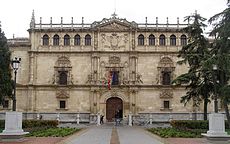 The plateresque facade of the old Alcala University.
The plateresque facade of the old Alcala University.
The major landmark and greatest pride of the city, its university, is spread throughout the city, but generally exists in two campuses. The first is on the north side of Alcalá. This campus includes most science departments and student housing (as well as its own, separate RENFE station). The second, central campus, houses most of the humanity and social science departments, including a law school.
The architectural influence of the university can be found in other present-day academic institutions. The University of San Diego is largely based on the Spanish University; its campus and address take the name "Alcalá Park." In addition, some buildings at Texas Tech University in Lubbock, Texas, were modeled after the architecture of Universidad de Alcalá de Henares.[3]
In 1496, Cardinal Cisneros founded the Universidad Complutense in Alcalá, which became famous as a centre of learning during the Renaissance. However, for economic reasons, the University was moved to Madrid in 1836 (under the name Universidad Complutense de Madrid). A new university was founded in the old buildings as the Universidad de Alcalá de Henares in 1977. Parts of the new University occupy the buildings of the old Universidad Complutense in the city centre, including the modern Colegio de San Ildefonso, and other Colegios, and the structures have served as a model for other universities across the Spanish territories in the Americas and other dependencies. For a time before their restoration and occupation by the modern University the old buildings had fallen into ruins, and where the population of the city at one point numbered some 60,000, in 1900 it had dropped to some 10,000 inhabitants.[citation needed]
The university chapel dedicated to Saint Ildefonso has a monument to the University's founder, Cardinal Cisneros, by Fancelli, an Italian sculptor.
It should be noted that while the present university is named "Universidad de Alcalá", the ancient institution founded by Cisneros is the one now called "Universidad Complutense" located in the capital city of Madrid ("Complutensis" is the Latin word for "native of Alcalá"). The modern University is related to the original institution in name only, although it occupies the former buildings of the Complutense.
Climate
The climate in this city of central Spain is the continentalised Mediterranean, with cold, dry winters and hot, dry summers. Rains fall mainly in spring and autumn. Temperatures vary from some degrees below 0 °C (32 °F) in December and January to some over 40 °C (104 °F) in July and August.
Geography
At an average of 654 m of altitude, on the southern part of the Meseta Central and occupying some 88 km²; the city was for a long time encapsuled between the hills and the river Henares to the south and east by the Madrid-Barcelona railway on the north and west. However, the expanding population has forced two new residential areas to be created between the railway and the motorway and beyond the latter. The historical centre lies roughly in the middle of the urban area. It is characterised by lower, Spanish Golden Age buildings, of which the most lavish belong to the University. These historic buildings gained for the city the title of World Heritage Site, awarded by the UNESCO in 1998.
Surrounding it there are the awful, high, swiftly built blocks of the 1960s, the Francoist era. They fill spaces to the north up to the railway line and to the west until the industrial zone begins. This was erected in the early 60s and has developed and expanded. Now it occupies a good third of the city's area being cut by the mentioned railway and motorway. To the east, the old blocks limit with a more recent area of lower blocks with gardens and (semi-)detached houses. This kind of construction also makes up the landscape of the new districts beyond the railway and the motorway.
The river remains widely underused. Although there are plans now in force to reconvert it into a major leisure place for the alcalaínos, it still presents no more than fairly good tracks for cycling and walking.
Immigration
Some 18% of the population are of foreign origin, according to the official data, a large part of the newcomers (30%) are immigrants from Eastern Europe. Many Chinese businesses have also been established in the city. Alcalá has the largest community (18%) of Romanian immigrants in Spain, with over 35.000 people. In 2007, for the first time, the immigrants from Romania created a political party for the elections to come. There is also a festival once a year, celebrated at the city central square (Plaza de Cervantes) dedicated to the people of Romania in Alcalá.
Transport
Alcalá's excellent transport links with Madrid have led to its becoming a commuter town, with many of its inhabitants travelling to work in the capital. It was affected particularly badly by the 11 March 2004 Madrid train bombings in Madrid as all the bombs were placed on trains that originated in, or passed through, Alcalá.
Ecclesiastical history
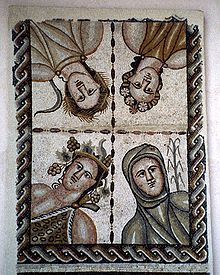 Roman mosaic (part of the archeological ensemble of Complutum) representing the four seasons from the House of Bacchus.
Roman mosaic (part of the archeological ensemble of Complutum) representing the four seasons from the House of Bacchus.
The town of historic importance was one of the first bishoprics founded in Spain.
The polyglot Bible known as the Complutensian Polyglot Bible, the first of the many similar Bibles produced during the revival of Biblical studies that took place in the sixteenth century, was printed at Alcalá under the care of Cardinal Cisneros.
A Papal Bull of 7 March 1885, united Alcalá with (effectively merging it into) the diocese of Madrid which includes the civil province of Madrid, suffragan of the archbishopric of Toledo, which was formally speaking not canonically erected before while its foundation dated from the Spanish Concordat of 1851.
The bishop's residence has since been used for preserving historical archives. It was designed by Alonso Berruguete and has a famous staircase.
Sister cities
Alcalá de Henares, as the birthplace of Catherine of Aragon, is twinned with the English city of Peterborough in England, her final resting-place.
 Alba Iulia, Romania
Alba Iulia, Romania Fort Collins, USA
Fort Collins, USA Guanajuato, Guanajuato, Mexico
Guanajuato, Guanajuato, Mexico Lublin, Poland
Lublin, Poland Peterborough, United Kingdom
Peterborough, United Kingdom San Diego, USA
San Diego, USA Talence, France
Talence, France
See also
- Complutenses, authors of the courses of Scholastic philosophy, theology and moral theology who were lecturers of the philosophical college of the Discalced Carmelites at Alcalá de Henares
References
- ^ "Las cigüeñas de Alcalá at The City of Alcalá's official web site (in Spanish)
- ^ This section incorporates information from the Spanish Wikipedia article Catedral de los Santos Niños Justo y Pastor de Alcalá de Henares licensed under the GFDL.
- ^ Barrick, Nolan (1985). Texas Tech... The Unobserved Heritage. Lubbock, Texas: Texas Tech University Press. pp. 18, 23. ISBN 0-89672-125-6.
Sources and external links
 This article incorporates text from a publication now in the public domain: Herbermann, Charles, ed (1913). "Madrid-Alcalá". Catholic Encyclopedia. Robert Appleton Company. Madrid-Alcala
This article incorporates text from a publication now in the public domain: Herbermann, Charles, ed (1913). "Madrid-Alcalá". Catholic Encyclopedia. Robert Appleton Company. Madrid-Alcala- Universidad de Alcalá
- Google Maps: The Plaza de Cervantes in Alcalá de Henares
- Photos of Alcalá de Henares
- Alcalá de Henares and its Famous University - by The Guardian
Municipalities of the Madrid Metropolitan Area Ajalvir · Alcalá de Henares · Alcobendas · Alcorcón · Algete · Aranjuez · Arganda del Rey · Boadilla del Monte · Brunete · Ciempozuelos · Cobeña · Collado Villalba · Colmenar Viejo · Coslada · Fuenlabrada · Galapagar · Getafe · Hoyo de Manzanares · Humanes de Madrid · Las Rozas de Madrid · Leganés · Madrid · Majadahonda · Mejorada del Campo · Móstoles · Paracuellos de Jarama · Parla · Pinto · Pozuelo de Alarcón · Rivas-Vaciamadrid · San Agustín de Guadalix · San Fernando de Henares · San Martín de la Vega · San Sebastián de los Reyes · Torrejón de Ardoz · Torrelodones · Tres Cantos · Valdemoro · Velilla de San Antonio · Villanueva de la Cañada · Villaviciosa de Odón
Municipalities of the Community of Madrid La Acebeda · Ajalvir · Alameda del Valle · El Álamo · Alcalá de Henares · Alcobendas · Alcorcón · Aldea del Fresno · Algete · Alpedrete · Ambite · Anchuelo · Aranjuez · Arganda del Rey · Arroyomolinos · El Atazar · Batres · Becerril de la Sierra · Belmonte de Tajo · El Berrueco · Berzosa del Lozoya · Boadilla del Monte · El Boalo · Braojos · Brea de Tajo · Brunete · Buitrago del Lozoya · Bustarviejo · Cabanillas de la Sierra · La Cabrera · Cadalso de los Vidrios · Camarma de Esteruelas · Campo Real · Canencia · Carabaña · Casarrubuelos · Cenicientos · Cercedilla · Cervera de Buitrago · Chapinería · Chinchón · Ciempozuelos · Cobeña · Collado Mediano · Collado Villalba · Colmenar de Oreja · Colmenar del Arroyo · Colmenar Viejo · Colmenarejo · Corpa · Coslada · Cubas de la Sagra · El Escorial · Estremera · Fresnedillas de la Oliva · Fresno de Torote · Fuenlabrada · Fuente el Saz de Jarama · Fuentidueña de Tajo · Galapagar · Garganta de los Montes · Gargantilla del Lozoya y Pinilla de Buitrago · Gascones · Getafe · Griñón · Guadalix de la Sierra · Guadarrama · La Hiruela · Horcajo de la Sierra · Horcajuelo de la Sierra · Hoyo de Manzanares · Leganés · Loeches · Lozoya · Lozoyuela-Navas-Sieteiglesias · Madarcos · Madrid · Majadahonda · Manzanares el Real · Meco · Miraflores de la Sierra · El Molar · Los Molinos · Montejo de la Sierra · Moraleja de Enmedio · Moralzarzal · Morata de Tajuña · Móstoles · Navacerrada · Navalafuente · Navalagamella · Navalcarnero · Navarredonda y San Mamés · Navas del Rey · Nuevo Baztán · Olmeda de las Fuentes · Orusco de Tajuña · Paracuellos de Jarama · Parla · Pedrezuela · Pelayos de la Presa · Perales de Tajuña · Pezuela de las Torres · Pinilla del Valle · Pinto · Piñuécar-Gandullas · Pozuelo de Alarcón · Pozuelo del Rey · Puebla de la Sierra · Puentes Viejas · Quijorna · Rascafría · Redueña · Ribatejada · Rivas-Vaciamadrid · Robledillo de la Jara · Robledo de Chavela · Robregordo · Las Rozas de Madrid · Rozas de Puerto Real · San Agustín del Guadalix · San Fernando de Henares · San Lorenzo de El Escorial · San Martín de la Vega · San Martín de Valdeiglesias · San Sebastián de los Reyes · Santa María de la Alameda · Santorcaz · Los Santos de la Humosa · La Serna del Monte · Serranillos del Valle · Sevilla la Nueva · Somosierra · Soto del Real · Talamanca de Jarama · Tielmes · Titulcia · Torrejón de la Calzada · Torrejón de Velasco · Torrelaguna · Torrelodones · Torremocha de Jarama · Torres de la Alameda · Tres Cantos · Valdaracete · Valdeavero · Valdelaguna · Valdemanco · Valdemaqueda · Valdemorillo · Valdemoro · Valdeolmos-Alalpardo · Valdepiélagos · Valdetorres de Jarama · Valdilecha · Valverde de Alcalá · El Vellón · Venturada · Villa del Prado · Villaconejos · Villalbilla · Villamanrique de Tajo · Villamanta · Villamantilla · Villanueva de la Cañada · Villanueva del Pardillo · Villanueva de Perales · Villar del Olmo · Villarejo de Salvanés · Villaviciosa de Odón · Villavieja del Lozoya · Zarzalejo
World Heritage Sites in Spain For official site names, see each article or the List of World Heritage Sites in Spain. North West Caves of Altamira and Paleolithic Cave Art of Northern Spain1 · Monuments of Oviedo and the Kingdom of the Asturias · Roman Walls of Lugo · Route of Santiago de Compostela1 · Santiago de Compostela · Tower of Hercules
North East Caves of Altamira and Paleolithic Cave Art of Northern Spain1 · Mudéjar Architecture of Aragon · Pyrénées - Mont Perdu2 · Rock-Art of the Mediterranean Basin on the Iberian Peninsula1 · Route of Santiago de Compostela1 · San Millán Yuso and Suso Monasteries · Vizcaya Bridge
Community of Madrid Aranjuez Cultural Landscape · El Escorial · University and Historic Precinct of Alcalá de Henares
Centre Archaeological Ensemble of Mérida · Archaeological Site of Atapuerca · Ávila with its Extra-mural Churches · Burgos Cathedral · Cáceres · Cuenca · Las Médulas · Rock-Art of the Mediterranean Basin on the Iberian Peninsula1 · Route of Santiago de Compostela1 · Salamanca · Santa María de Guadalupe · Segovia and its Aqueduct · Toledo · Prehistoric Rock-Art Sites in the Côa Valley and Siega Verde
East Archaeological Ensemble of Tarraco, Tarragona · Catalan Romanesque Churches of the Vall de Boí · Ibiza (Biodiversity and Culture) · Palau de la Música Catalana and Hospital de Sant Pau, Barcelona · Palmeral of Elche · Poblet Monastery · Rock-Art of the Mediterranean Basin on the Iberian Peninsula1 · Silk Exchange in Valencia · Works of Antoni Gaudí
South Alhambra, Generalife and Albayzín, Granada · Cathedral, Alcázar and Archivo de Indias, Seville · Córdoba · Doñana · Renaissance Monuments of Úbeda and Baeza · Rock-Art of the Mediterranean Basin on the Iberian Peninsula1
Canary Islands 1 Shared with other region/s · 2 Shared with France Categories:- Alcalá de Henares
- World Heritage Sites in Spain
Wikimedia Foundation. 2010.

